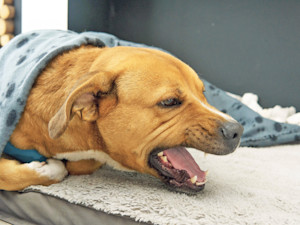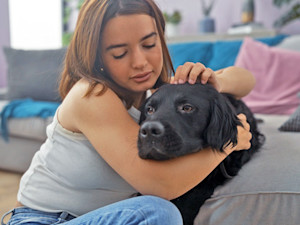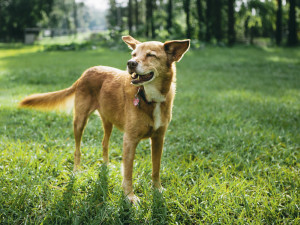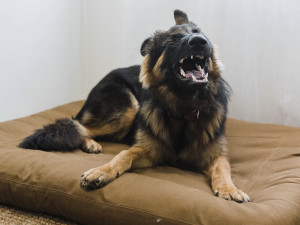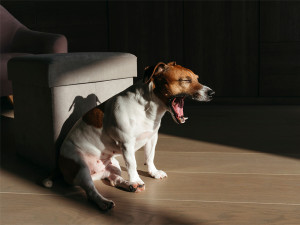How to Soothe a Dog with a Collapsed Trachea
Signs to look out for.

Share Article
In This Article:
How to Identify a Collapsed Trachea in Dogs How Do Dogs Get a Collapsed Trachea? What Are the Symptoms of Collapsed Trachea in Dogs? How Vets Diagnose Collapsed Trachea in Dogs How Vets Treat Collapsed Trachea in Dogs How to Treat Collapsed Trachea in Dogs at Home When to Seek Emergency Care
A common history given by parents of dogs with tracheal collapse looks like this: My dog has been wanting to do less recently. They’ve been coughing whenever they pull on their leash. When they got excited today, they started with a fit of coughing that sounds like a wheezing honk and hasn’t stopped. I’m worried they’re having trouble breathing now.
This scenario is something seen frequently in emergency practice. Tracheal collapse has a gradual onset, but it doesn’t always make itself obvious until a dog is in distress. This leaves some pet parents in a situation where they wish they could have taken steps to slow the progression of the disease. Recognizing the early signs of tracheal collapse can help with this.
How to identify a collapsed trachea in dogs
Some basic respiratory anatomy is necessary to understand how dogs develop tracheal collapse and how to recognize the signs of a collapsed trachea in dogs. When dogs breathe, air enters through their nose or mouth and travels through the throat area, called the pharynx, before reaching the larynx.

The larynx is a complex structure that lets people talk and dogs bark, among other functions. During both inhalation and exhalation, the vocal cords open wide to allow air through to the trachea. The trachea is a long tube that connects the upper airway (nose, mouth, pharynx, and larynx) to the rest of the lower airway (bronchi and lungs). Some people think of the trachea as a rigid structure, but it’s actually quite flexible. This flexibility allows the trachea to adjust to a wide range of head and neck movements.
The trachea is flexible because it’s made of a series of thirty-six to forty-five C-shaped pieces of cartilage with thin ligaments between them. The edges of the C-shaped rings are connected by a muscle referred to as the dorsal tracheal membrane. This means the inside of the trachea is normally somewhere between a D and a C shape, giving it a less perfectly round shape than people usually picture.
The presence of that soft membrane on the top (facing your dog’s spine) of the trachea helps to prevent the trachea from kinking when the neck is flexed or extended. The membrane is important to tracheal function and plays a big role in tracheal collapse.
Definition
So, what is tracheal collapse? Tracheal collapse is a reduction in the diameter of the trachea, most commonly due to weakening or malformation of the tracheal rings and stretching of the dorsal tracheal membrane. Tracheal collapse is graded on a one to four scale depending on its severity. A dog with grade one tracheal collapse has up to 25 percent reduction in the diameter of their tracheal lumen, while a dog with grade four collapse has 90 to 100 percent reduction in the tracheal diameter, with the dorsal tracheal membrane often touching the opposite side of the trachea.
How do dogs get a collapsed trachea?
Tracheal collapse happens because the tracheal cartilage weakens, leading to a change in the shape of the trachea and stretching of the dorsal tracheal membrane. These changes in the diameter and shape of the trachea lead to progressive issues as this normally semi-rigid tube begins to deform and eventually collapses. There are a lot of physics concepts and boring (to me — maybe you like complex math) equations involved in this disease. For my simple emergency vet brain, it works like this:
Your dog needs to breathe a certain amount of air in a given time period to keep their cells oxygenated and get rid of carbon dioxide.
If the tube the air is moving through gets smaller, the air has to move faster to keep up with demand.
The faster the air moves through the tube, the more pressure (drag) it creates on the walls of the tube.
The extra pressure on the walls of the trachea further weakens the walls and narrows the lumen, compounding the problem.
The amount of air needed increases when more energy is needed for things like playing and getting worked up about the doorbell. Think of it like trying to breathe through a boba straw or one of those giant straws you get when you order a thick milkshake with chunks of cookies in it. This doesn’t seem so bad as long as you’re sitting still. It wouldn’t be super fun to run a 5k breathing through one of those, but you could maybe manage it.
Now think about trying to breathe through a normal drinking straw instead. You start off trying to breathe slowly and calmly, but it’s not possible to get enough air through it at your normal respiratory rate. Before long, your body will tell you you’re not getting rid of enough carbon dioxide, and you really need to do something about that. So, you start breathing faster, but now you can feel more drag as the air moves through the straw. You really have to work to push and pull each breath through. The straw wasn’t built for this extra pressure, so it starts to flex a little with each breath and eventually collapses every time you inhale.
Sorry if that made you a little panicky, but it’s the most relatable way to think about the forces at play with tracheal collapse. But why do dogs start having tracheal issues in the first place?
Breed predisposition
Tracheal collapse tends to be a problem of small-breed and toy-breed dogs. Yorkshire Terriers, Pomeranians, and Poodles are some of the most commonly affected breeds. The prevalence in these breeds indicates that genetic origin is likely, but the full genetic factors haven’t been worked out yet. All we know is that dogs with tracheal collapse suffer from cartilage problems that make the tracheal rings softer and more flexible than they should be.
Obesity
Obesity worsens most respiratory issues, and tracheal collapse is one of them. Increased weight means increased tissue demands for oxygen, less room for normal anatomy, and more work needed to take each breath.
Age
While age doesn’t cause tracheal collapse by itself, dogs who are predisposed to tracheal collapse are more likely to show symptoms as they get older. Weakening of the tracheal rings and stretching of the dorsal tracheal membranes are gradual processes. Dogs may be born with abnormal cartilage that holds up to wear and tear for years but eventually begins to break down.
Respiratory issues
Problems like laryngeal paralysis and abnormal upper airway anatomy (as seen with flat-faced breeds) alter the normal pressure gradients in the trachea during breathing. This can increase the pressure pushing and pulling on the tracheal rings with each breath, hastening tracheal collapse. Respiratory infections and recent tracheal intubation for an anesthetic procedure can also exacerbate tracheal collapse.
Chronic bronchitis
Dogs with chronic bronchitis have changes in their lungs due to inflammation triggered by allergies, irritants, or infections. Tracheal collapse may be associated with chronic bronchitis due to changes in respiratory patterns and chronic coughing.
Environmental factors
While they are unlikely to be a primary cause of collapsing trachea in dogs, environmental irritants can certainly worsen the disease and result in episodes of distress. Some common environmental triggers for tracheal collapse episodes include:
Smoke
Dust
Air pollution
Cleaning products
Essential oils
Potpourris
What are the symptoms of collapsed trachea in dogs?
In the early stages of the disease, tracheal collapse may not have many obvious symptoms. Until the airway has narrowed significantly, dogs with a collapsing trachea can act perfectly normally. As the disease progresses, the airflow restriction becomes more obvious and begins to cause problems. Some common symptoms of collapsed trachea in dogs include:
“Honking” cough
The cough associated with a collapsed trachea in dogs sounds kind of like a goose honk. This distinct type of cough is created by the vibration of tissues in the trachea during a strong exhalation to “pop” the trachea back open as it collapses. Coughs of this type often repeat with each breath in distressed dogs as they try to keep their airway open.
Trouble breathing
Tracheal collapse can occur either inside the chest (intrathoracic) or in the neck (extrathoracic). Dogs with intrathoracic tracheal collapse will have trouble exhaling normally due to the increased pressure within the chest cavity during exhalation. Extrathoracic tracheal collapse causes dogs to struggle to inhale normally.
Difficulty exercising
Exercise intolerance is common in dogs with tracheal collapse. For dogs with severe disease, any excitement can trigger a bout of coughing and difficulty breathing. Dogs with tracheal collapse often do not tolerate neck leads or a leash attached to their collar well due to the increased pressure on their trachea.
Gagging or retching
Episodes of coughing can be followed by gagging or retching. This can be mistaken for vomiting by concerned pet parents but is generally thought to be due to an activation of the gag reflex rather than true nausea.
Blue gums (cyanosis)
Episodes of coughing and difficulty breathing due to tracheal collapse can lead to low blood oxygen levels. If severe, dogs may appear to have pale or bluish gums during or immediately after bad coughing fits. In the worst cases, dogs can faint from a lack of oxygen associated with tracheal collapse.
Abnormal Breathing
Dogs with tracheal obstruction of any sort can show symptoms like an extended head and neck, standing with their elbows wide, and increased respiratory effort. Even between coughing episodes, a narrowed trachea can result in a change in respiratory noise. Dogs with tracheal collapse often have changes to their normal breathing, including an increased respiratory rate, wheezing, or gurgling sounds.
How vets diagnose collapsed trachea in dogs
Figuring out how to diagnose collapsed trachea in dogs when they’re having severe respiratory distress can be a challenge for veterinarians. In my experience, it’s often best to begin basic treatments like sedation, providing extra oxygen, and cooling (if necessary) that help with all types of respiratory distress before attempting diagnostics. It’s easier and safer to do diagnostics when a distressed dog is more stable and relaxed.
Physical assessment techniques
A complete physical examination can lead your veterinarian to suspect tracheal collapse and help rule out other issues. The cough associated with tracheal collapse is fairly distinct, though a diagnosis cannot be made on the sound of a cough alone. A coughing episode can sometimes be triggered by putting light pressure on the trachea. The trachea may also feel flattened if the collapse is occurring in the neck.
Diagnostic tests
In addition to tests to rule out other possible causes of cough like heartworm disease, imaging can confirm a diagnosis of collapsing trachea.
Radiographs: X-rays of the neck and chest may show a flattening of the trachea that indicates tracheal collapse. Radiographs aren’t always diagnostic because they may not catch the exact moment the trachea is closed, depending on when in the respiratory cycle they are taken.
Fluoroscopy: Fluoroscopy is basically a video x-ray. It can show what is happening throughout the respiratory cycle and during a coughing episode. Fluoroscopy is not commonly available in veterinary clinics, and it can still miss some cases of tracheal collapse due to overlapping structures in the neck and chest.
Bronchoscopy: Bronchoscopy provides the most definitive diagnosis of the presence and extent of tracheal collapse. During bronchoscopy, a small, flexible probe with a video camera on it is passed into the trachea through the mouth under anesthesia. This allows visualization of the function of the larynx, tracheal size, dorsal tracheal membrane, and bronchi. During this procedure, airway sampling can be done to check for infection, inflammation, parasites, or cancer
How do vets treat collapsed trachea in dogs
How to treat collapsed trachea in dogs is not a simple course of action. There’s no way to repair the weakened cartilage and loose dorsal tracheal membrane. Emergency stabilization is needed for dogs in distress. Once their condition is stabilized, medical management is usually attempted before surgical interventions are considered. There are many medications for dogs with collapsed trachea, but each dog will respond differently to them and require a specific combination to keep their disease under control.
Medications
Cough suppressants: These are useful for keeping the cough associated with tracheal collapse under control, which can help to reduce inflammation and further weakening of the tracheal rings.
Steroids: Short courses of corticosteroids (like prednisone) may be used during bad episodes to reduce swelling. Chronic use of corticosteroids can result in weight gain, panting (which puts more pressure on the trachea), immune suppression, and muscle wasting. A course of anabolic steroids (like stanozolol) may help some dogs, but these drugs may be difficult to obtain.
Bronchodilators: These drugs help to open small airways and increase airflow during exhalation. They won’t help directly with the large airways like trachea and bronchi but may provide some benefit in cases where small airway collapse is suspected.
Sedatives: Times of anxiety or excitement can trigger tracheal collapse episodes. Sedation can help to reduce the likelihood of a bad event. Some dogs may need sedatives daily, while others may only need them when a potential trigger (like visitors, a car ride, or a thunderstorm) is expected.
Antibiotics: Dogs with tracheal collapse or other concurrent airway issues may be predisposed to respiratory infections. Antibiotics may be recommended in cases where an infection is suspected based on history, radiographs, or airway sampling.
Surgery
Surgical interventions for tracheal collapse may be attempted in pets that have had life-threatening episodes of tracheal collapse or when medical management fails to control symptoms and provide good quality of life. There are two procedures used for tracheal collapse: rings placed around the trachea to hold it open (used for collapse in the neck) and a mesh stent that expands within the tracheal lumen to help hold it open. Post-surgical improvement rates are high, but both procedures have significant major complication rates.
How to treat collapsed trachea in dogs at home
Much of the ongoing care for tracheal collapse will be done at home. Pet parents of dogs with tracheal collapse should expect to adjust their environment and lifestyle to help manage their dog’s disease. This goes beyond learning how to carry a dog with tracheal collapse (under the chest and pelvis). Because tracheal collapse can’t be cured, home care focuses on slowing progression of the disease and avoiding episodes of cyclic coughing. Some strategies to help manage tracheal collapse in dogs at home include:
Weight management
Even though it’s difficult in dogs who can’t tolerate much activity or excitement, weight loss is vital for dogs with tracheal collapse. Pet parents are often amazed at how much difference getting their dog to a lean body condition helps with their breathing and overall comfort level. The importance of maintaining an appropriate weight in dogs with collapsing trachea can’t be stressed enough.
Avoiding airway irritants
Anything out of the norm can cause tracheal irritation that can trigger inflammation and worsen tracheal collapse. Avoid strongly scented candles, cigarette smoke, dusty areas, fire pits, and fireplaces. When using cleaning products, try to make sure there’s good air circulation and keep your dog out of the area until the products have dried.
Maintaining a calm environment
Some things can’t be avoided (who knows when the delivery person will show up) but try to stick to a routine your dog knows and likes as much as possible. Make sure any visitors know not to get your dog riled up and overexcited. Discuss sedatives with your veterinarian beforehand if you know something outside of your dog’s usual routine is coming up.
Cooling
Hot, humid air makes dogs pant. Panting can worsen tracheal collapse, so keep your dog’s environment cool and dry whenever possible.
Using a harness instead of a collar
Collars can put pressure directly on the trachea and trigger coughing episodes. Switching to a chest harness will help keep your dog comfortable on walks.
Elevating food and water bowls
Some dogs may prefer having their food and water bowls raised to a level where they don’t have to bend their neck to eat and drink. This could prevent tracheal discomfort.
Providing comfortable bedding options
Some pet parents report that their dog with tracheal collapse sleeps in a different position than usual. Some may prefer having their head stretched out or elevated slightly to prevent bending of the trachea. The best sleeping position for a dog with collapsed trachea is the one they find most comfortable. Don’t wake your dog up to force them into a position you think is better for their trachea. Just provide a variety of comfortable bedding options so they can choose what’s best for them.
When to seek emergency care
Always see a veterinarian as soon as possible if you feel your dog is in any sort of respiratory distress. Respiratory issues can worsen quickly, so don’t wait: get them checked out early.
Warning signs of worsening condition
If your dog has tracheal collapse, your vet can help guide you on steps to take at home when you notice an episode coming on. Some potential signs include increased wheezing, restlessness, an uptick in coughing frequency, and reluctance to eat or drink. Your veterinarian may recommend additional sedation, steroids, or other therapies to help ward off a severe episode.
Symptoms requiring immediate attention
If your dog is in respiratory distress, get them to your vet or a veterinary ER as soon as possible. Signs of a severe episode of tracheal collapse include:
Severe coughing or honking, especially repeated or cyclic honking episodes
Labored or rapid breathing
Standing with head and neck extended
Lethargy
Inability to rest
Increased respiratory noise
Pale or bluish gums
Collapse
References
Canine Tracheal Collapse. Southwest Veterinary Symposium, 2022.
Dabanoğlu, I., et al. “A Quantitative Study on the Trachea of the Dog.” Anatomia, Histologia, Embryologia, vol. 30, no. 1, 1 Feb. 2001, pp. 57–59, pubmed.ncbi.nlm.nih.gov/11284164/, https://doi.org/10.1046/j.1439-0264.2001.00301.xopens in new tab. Accessed 18 Oct. 2022.
Della Maggiore, Ann. “An Update on Tracheal and Airway Collapse in Dogs.” Veterinary Clinics of North America: Small Animal Practice, vol. 50, no. 2, Mar. 2020, pp. 419–430, https://doi.org/10.1016/j.cvsm.2019.11.003opens in new tab.
Tracheal Stents: Indications. IVECCS Symposium, 2021.

Dr. Bartley Harrison, DVM
Dr. Bartley Harrison is a veterinarian with more than 19 years of experience. He has treated a variety of species in emergency and speciality practices for both large and small animals. His primary interests as a vet are emergency medicine and critical care.
Related articles
![Woman cuddling her sick black dog at home.]()
Diagnosing Kennel Cough in Dogs: A Comprehensive Guide
When to call the vet.
![A dog outside with his mouth open coughing]()
Respiratory Illnesses in Dogs: 6 Serious Conditions Related to Coughing in Dogs
Vet advice on when you should be worried.
Reverse Sneezing or Honking Noise in Dogs: Causes and Treatment
Don’t panic: It’s called reverse sneezing, and in most cases, it’s nothing to worry about.
![A dog with its eyes closed and mouth open sitting on a hardwood floor.]()
How to Help a Choking Dog and Prevent Choking In the First Place
Learn about the causes and what to do for a choking pet.
Why Does My Dog Snore?
It seriously sounds like another human being is in the room.
Does Your Dog Need a Flu Shot?
“Sick as a dog” isn’t just a phrase.

